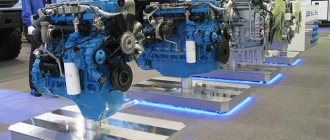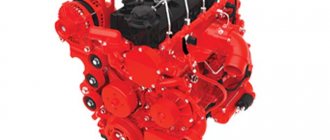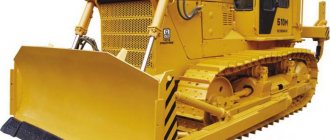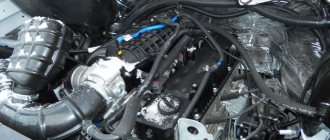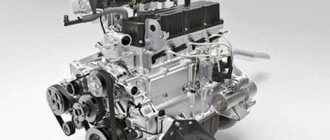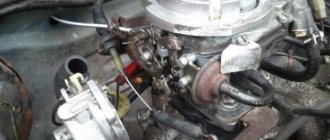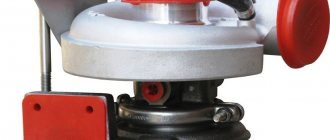Diesel engine Gazelle Next or Cummins ISF2.8s4129P, the engine that generations of owners of small trucks and vans produced by GAZ have dreamed of. Low fuel consumption and huge torque are perhaps the main requirements for buyers of commercial vehicles. The 4-cylinder diesel power unit with a turbocharger and charge air cooler with a displacement of 2.8 liters is quite an interesting option, which we will talk about in more detail.
Cummins engines for Gazelles are supplied from China, where they are assembled at the Beijing plant of the American corporation Cummins. The American manufacturer of diesel engines has quite a few factories around the world. In addition to the 2.8-liter unit, the GAZ conveyor is supplied with a more powerful Cummins ISF 3.8-liter diesel engine for medium-duty trucks and buses.
Once every 15 thousand kilometers, the diesel Gazelle Next requires changing the oil and filters. Ignoring the maintenance regulations specified by the manufacturer is fraught with problems in the future. Poor quality fuel and oil can kill an engine quite quickly. Under normal operating conditions, a Gazelle Next with a Cummins engine can easily cover 500,000 kilometers without major repairs.
First, let's talk about the main technical characteristics of a turbodiesel. With a fairly large volume of 2.8 liters, the unit’s power is 120 horsepower, but the torque is an impressive 270 Nm (although there are more powerful versions). A special feature of the engine can be considered that the maximum torque is available from 1400 rpm. That is, there is no need to turn the engine at maximum speed in order to drive a GAZ lorry normally and also carry a couple of tons of cargo.
Characteristics of the Gazelle Next diesel engine
- Working volume – 2800 cm3
- Number of cylinders – 4
- Number of valves – 16
- Cylinder diameter – 94 mm
- Piston stroke – 100 mm
- Timing drive - chain
- Power hp (kW) – 120 (88.3) at 3600 rpm. per minute
- Torque – 270 Nm at 1400-3000 rpm. per minute
- The operating order of the cylinders is 1-3-4-2
- Minimum speed – 750 revolutions
- Fuel type – diesel
- Fuel consumption when constantly driving 60 km/h - 8.5 liters per hundred
- Fuel consumption when constantly driving 80 km/h – 10.3 liters per hundred
Specifications
The Gazelle Business was equipped with a Cummins diesel engine, which performed quite well and was loved by drivers for its simplicity and reliability. But the installation of Cummins internal combustion engines did not stop there, and with the release of Gazel NEXT in 2013, the tradition continued.
Main technical characteristics of the Gazelle power unit with a Cummins engine:
| Name | Characteristic |
| Manufacturer | Cummins |
| Model | ISF 2.8s |
| Engine capacity | 2.8 liters |
| Modifications | 3129T |
| Motor type | Turbocharged diesel |
| Injection type | injection pump |
| Engine power | 120 hp |
| Number of cylinders | 4 |
| Number of valves | 8 |
| Piston diameter | 94 mm |
| Piston stroke | 100 mm |
| Cooling | Liquid |
| Resource | 500,000 km |
| Econorm | Euro 4 |
Cummins engine design for Gazelle Next
Inline 4 cylinder 16 valve engine with cast iron cylinder block and cast iron cylinder head with overhead camshaft. The cylinder head has a single camshaft, which rotates via a chain drive that comes from an intermediate gear. The rotation of the oil pump and high pressure fuel pump is carried out using gears. The main gear stands on the crankshaft and drives the drive gears of the common rail injection pump, plus the timing gear, which transmits torque through the chain to the camshaft. The rotation of the water pump is carried out by a poly-V-belt, which also rotates the fan through a viscous coupling. The diagram of the gear drive and timing chain is shown in the photo below.
Power unit repair
Repair of the Cummins Gazelle engine is recommended to be carried out at service technical stations. Although the design is simple, the motor has a number of nuances that the owner of the vehicle does not even know about. Thus, the oil pump requires certain equipment in order for the repair to be high-quality. The same fate befalls the fuel pump, when repairing it it is necessary to clearly set the gaps.
The power unit is serviced every 15,000 km. This process includes operations to replace engine oil, oil filter, as well as fine and coarse fuel filters. Also, maintenance carries out diagnostics of the fuel pump and injectors.
Cleaning of injection elements is carried out as they become clogged, but the manufacturer recommends doing the procedure every 50,000 km. This will prolong the operation of the injectors.
Major repairs also require some equipment, so in this case, the principle does not work - we repair it ourselves. Although some motorists carry out restoration work with their own hands.
As in any case, you can disassemble the power unit yourself, but it is impossible to bore the block and crankshaft without special machines. Therefore, most owners of Cummins engines turn to car services. Although the engine has a service life of 500,000 km, they still do not last forever.
The crankshaft is bored to repair sizes of 0.25 mm, 0.50 mm and 0.75 mm. Further turning of the part weakens the hardness, which in turn increases the risk of the crankshaft breaking under heavy loads. The piston group is generally bored to a size of no more than 95.5 mm, and then a block sleeve is provided, which is quite convenient.
Cummins engine block head for Gazelle Next
The cylinder head has a design with vertically standing valves. There are 16 valves, that is, 4 per cylinder. The camshaft transmits the force to open the valves through rocker arms. The camshaft cams touch the rollers mounted on the rocker arms, driving them.
There are only 8 rocker arms; under their influence, two valves come off at once. A very important point is the timely adjustment of the valve thermal clearance. It is carried out once every 120 thousand km. The adjustment unit is elementary, consisting of a screw and a nut. All this can be seen in the photo below.
If you do not adjust the valves, then at one point the valve will push a little more than permissible into the combustion chamber and the valve will meet the piston, and this, as you understand, is a very expensive repair.
By the way, the same Cummins 2.8 engine, but with different settings, can produce 149.6 horsepower with a torque of up to 330 Nm. The increased power unit has been installed on some GAZelle Next modifications since the fall of 2015. The increase in power occurred due to new turbocharging settings and flashing of the electronic control unit. True, at the same time we had to strengthen the transmission. The ZF Sachs clutch now comes with an increased diameter of the driven disc, it has been increased from 240 to 280 mm. The gearbox has reinforced bearings and new synchronizers. The design of the rear axle has also been modernized, in particular the drive gear bearing has been strengthened.
Design and principle of operation of the motor
It is necessary to start with the fact that the Cummins engine is very unpretentious to fuel. This became possible thanks to a new, modernized fuel purification system. The power unit is equipped with a new CommonRail fuel supply system. In this case, fuel is supplied directly into the combustion chamber under high pressure.
As for the gas distribution mechanism, everything is very simple and reliable. The cylinder head gasket consists of several steel sheets, which prevents it from burning out quickly, unlike other diesel engines.
The engine, which is mounted on the Gazelle, is equipped with a 4-valve gas distribution system, which ensures maximum technical characteristics and the required power. The timing chain has a chain with a tensioner, which ensures the reliability of the mechanism and sufficient strength. The camshaft is located according to the classical design.
Checking valve clearances should be carried out every 80,000 km, but valves need to be adjusted every 250,000. The standard valve clearance is: 0.38 mm for intake, and 0.76 for exhaust.
The fuel pump has a rather complex structure, which almost reduces the possibility of repairing it at home to zero. But, due to its reliability, it uninterruptedly provides high pressure, which is 1800 bar.
Also, an electronic controller is installed, which provides quality control of the fuel supplied to the injectors.
As for the cooling system, it is closed and can be configured for operation in different weather conditions. This becomes quite convenient since there is a significant difference in engine operation in warm and cold regions.
About company
After the invention of the diesel engine, the enterprising American mechanic Clessie Cummins was able to consider the potential of the unit. At that time, he did not have the capital to create a company, however, teaming up with entrepreneur William Glanton, the Cummins Engine Company corporation was founded in the 19th century.
Working for fourteen years on the promotion and calculation of engines, the efforts were crowned with success; in 1933, the company released the Cummins “H” series diesel engine to the masses. This unit launched a series of family units that made the corporation famous.
In the fifties of the last century, the boom in the United States of America in the construction of highways helped the company become a leader, selling more than other diesel power plants. Every driver wanted a reliable, trouble-free unit on his car. A competent approach to organizing the team’s work allowed the corporation to increase sales volumes and, by the end of the 50s, take first place in the diesel units market.
Today, the company covers dozens of areas, the scope is constantly expanding. A division of Cummins Inc. is a world leader that produces, designs, develops, and also services Cummins diesel engines of the same name. The corporation develops fuel equipment, filters, lubricants, chemical products, etc.
The corporation's industry is concentrated in 17 distributor companies and 10 enterprises, which are scattered across 190 countries and regions. Cummins diesel engines are constantly being improved, using modern solutions and satisfying the need for reliable work equipment.
Founders of Cummins Engine Company: Clessie Lyle Cummins and William Glanton Irwin.
Selecting the right lubricant
Information on choosing the right oil is also in the Gazelle Next operating instructions. For Gazelle with a Cummins diesel engine, the manufacturer recommends using Shell Rimula R6 10W-40 or Shell Helix HX7 Diesel 10W-40. And for gasoline - Shell Helix HX7 5W-40. This oil is quite common in almost all car stores in any city, so there will be no problems with its selection and purchase. We do not recommend using another oil, because in this case a 100% guarantee of engine wear protection is not guaranteed.
Tools required for changing
To carry out the oil change procedure on your own, you will need the following materials and tools:
- First, you need to buy the consumables that you will change, namely: new lubricant taking into account the required displacement, a new oil filter and a new gasket for the drain bolt.
- Secondly, this is the tool that you will need to carry out the procedure. This is a puller for removing the old filter, keys for removing the engine protection and unscrewing the drain hole.
- You will also need a container into which you will drain the waste.
Do-it-yourself algorithm for changing engine oil in a Gazelle Next engine
First, warm up the engine of your car. This is done so that the waste flows out easily from the pan and engine of the machine. After this, place an empty waste container under the pan and unscrew the drain plug. Also unscrew the filler hole to avoid the formation of a vacuum in the engine, which will reduce the time it takes to drain the old oil. At first, the oil will flow quite quickly, but then in drops until it runs away from all components of the power unit.
While the waste fills the container, you can remove the old oil filter and install a new one.
But before installing a new filter, you need to pour approximately 150 grams of new oil into it and only then install it in place. After the power unit of your car is completely free of waste, tighten the drain hole with a bolt. Next, fill in new engine oil and tighten the filler plug.
After the change, let the machine run for about 15 minutes, then check the level with the engine turned off. This completes the oil change.
Oil change intervals
For people who are going to buy Gazelle Next, the manufacturer presents a choice of a line of engines that will appeal to both fans of gasoline and diesel engines, and those who like to drive on gas. The power units that are installed on these cars are quite reliable even with regular transportation of massive objects. But do not forget that in order to extend the life of these engines, or at least not kill them, you must always carry out maintenance on time. To do this, you need to read the operating instructions and maintenance regulations for Gazelle Next. In addition to information about the mileage at which maintenance is required, you can find in these books a lot of new and necessary information for you. The oil change procedure and its features are no exception.
Every engine needs to change the engine oil from time to time to operate properly. Most engines have approximately the same mileage at which this procedure needs to be carried out, but each manufacturer makes its own recommendations. For diesel engines, GAZ recommends changing them once every 10,000 kilometers, and for gasoline units - once every 10,000 - 15,000 kilometers. Always remember that when changing engine lubricant, the oil filter must also be changed.
Conclusion
The Cummins Gazelle engine has established itself as a reliable and easily repaired power unit. The engine size allows you not only to obtain the necessary power, but also to be quite economical with an average consumption of 10 liters for every 100 km.
The engine design is quite simple, which allows you to carry out repair and restoration work yourself without any problems. As for the oil pump, turbine and fuel injection pump, it is recommended to repair them at specialized service stations, since the design is quite complex.
Throughout its production history, Gazelle has been equipped with many powertrain options. So, there were ZMZ, UMZ, and other engine options. Of course, one of the most powerful options was the Cummins Gazelle engine, which was equipped with cars, mainly of the Business class.
Advice from experienced Gazelle drivers for winter use
The first owners of the modernized cars had no one to consult with, so through trial and error they found for themselves, and then formulated on forums and websites the best recommendations for operating Kamens engines on the Gazelle in reviews.
Regarding the winter use of the car, drivers indicate that for a diesel engine, winter begins when the thermometer shows + 5°C. This means that we need to start preparing for the more severe conditions that are typical for Russia.
It has been noticed that the main engine problem in winter is a cold start. Therefore, before the start of winter, you should carry out a thorough inspection of the car - check the engine, starter, injection system, battery and generator. Car enthusiasts give a lot of advice, and in order not to get confused, everyone should carefully analyze them.
In winter, the most important thing is the battery, which is better to have high power. Don’t forget to check the electrolyte level in it and the presence of oxidation processes. The battery should be cleaned, the glow plugs checked for serviceability, and the terminals covered with a protective layer. The starter and battery should be filled with low viscosity oils.
In the Cummins engine itself, the oil must be changed every 15 thousand kilometers, but do not forget about operating conditions and fuel quality. The worse the latter, the more often the oil change is necessary. The engine manufacturer recommends a viscosity of 15W-40/5W-40 - it is suitable for all seasons.
Repair of Cummins ISF 2.8 is best done at a stand. The engine should be removed as assembled as possible. This will save time and make the whole process easier.Depending on the design of the combustion chambers in the fuel system, different types of injectors are used. You can learn about the structure of the fuel system from this article.
Before the start of winter, it is a good idea to replace your coolant, brake, and power steering fluid. This will ensure that Gazelle vehicles with a Cummins engine, reviews of which are available on many Internet resources, have trouble-free operation in winter.
Starting the engine itself in cold weather can be facilitated by a preheater and an autostart function.
At the moment, on all diesel Gazelles with more than three passenger seats, a pre-heater is installed at the factory.
It promotes quick start-up even in severe frosts. And the alarm system with auto-start allows you to immediately get into a warm cabin without wasting time waiting for it to warm up.
An autonomous heater, independent of engine operation, ensures heating of the cabin between long stops. The insulated walls of the Gazelle help retain heat in frosty weather.
Cummins Cooling System
All brand engines have a closed cooling system. The design of the Kamens engine ensures that this system is configured for various climatic conditions. Kamaz and Gazelle trucks can be operated at temperatures up to +45°C.
The system is charged with SHELL brand coolant and other high-quality coolants. If you use non-certified fluids, premature wear of the pump is possible. To protect against overheating, a forced radiator airflow system is used.
The cooling system has the following features to increase system reliability:
- a larger volume intercooler is used;
- There is a heated intake manifold.
If the engine overheats, the electronic control system has the ability to cut off the fuel supply to prevent further movement of the vehicle.
Thus, all components, systems and mechanisms that make up Kamens engines are designed and manufactured in such a way that motors of this brand are distinguished by a high level of reliability, subject to compliance with the terms and maintenance rules established by the manufacturer.
Design and principle of operation of the motor
It is necessary to start with the fact that the Cummins engine is very unpretentious to fuel. This became possible thanks to a new, modernized fuel purification system. The power unit is equipped with a new CommonRail fuel supply system. In this case, fuel is supplied directly into the combustion chamber under high pressure.
As for the gas distribution mechanism, everything is very simple and reliable. The cylinder head gasket consists of several steel sheets, which prevents it from burning out quickly, unlike other diesel engines.
The engine, which is mounted on the Gazelle, is equipped with a 4-valve gas distribution system, which ensures maximum technical characteristics and the required power. The timing chain has a chain with a tensioner, which ensures the reliability of the mechanism and sufficient strength. The camshaft is located according to the classical design.
The fuel pump has a rather complex structure, which almost reduces the possibility of repairing it at home to zero. But, due to its reliability, it uninterruptedly provides high pressure, which is 1800 bar.
Also, an electronic controller is installed, which provides quality control of the fuel supplied to the injectors.
As for the cooling system, it is closed and can be configured for operation in different weather conditions. This becomes quite convenient since there is a significant difference in engine operation in warm and cold regions.
